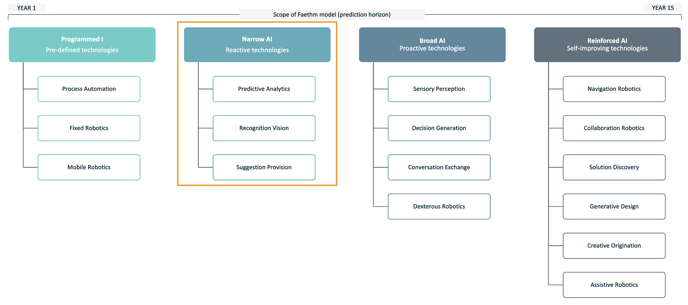Narrow AI
Narrow Artificial Intelligence technologies are semi-autonomous but are purely reactive.

Narrow AI acts semi-autonomously when prompted by humans. These technologies perform structured, familiar tasks in defined domains by using machine learning to interpret certain problems.
Predictive Analysis
Tools that reactively use ML to conduct narrow analysis and make related predictions.
- Business Intelligence (BI) Systems
- Database manipulation software
- Data visualisation technologies
For example, SAP’s HANA is an in-memory data platform and database management system which stores and retrieves data and performs advanced analytics. Companies use HANA to receive data-driven insights and to predict real-time outcomes and solutions.
Recognition Vision
Tools that reactively use ML and sensors to recognise and classify data meaningfully.
- Computer vision API
- Facial Recognition
- Medical Image recognition
For example, Google’s Cloud Vision API is trained to decipher and analyse images. The program can recall learnings to suggest the content of an image, classify images into thousands of categories (such as, “sailboat”), detect objects and faces within images, and read printed words contained within images. individual
Suggestion Provision
Tools that reactively use ML to prioritise data to identify relevant recommendations.
- Social media site recommendations
- Online targeted advertising
- Search engines
For example, SkyHive’s job matching platform is able to match job-seekers with employers based on skills. Powered by machine learning, SkyHive connects job seekers with suggested work opportunities based on the highest skill match, effectively eliminating biases and inefficiencies while providing both job seekers and employers with optimal match results. Narrow AI acts semi-autonomously when prompted by humans. These technologies perform structured, familiar tasks in defined domains by using machine learning to interpret certain problems.